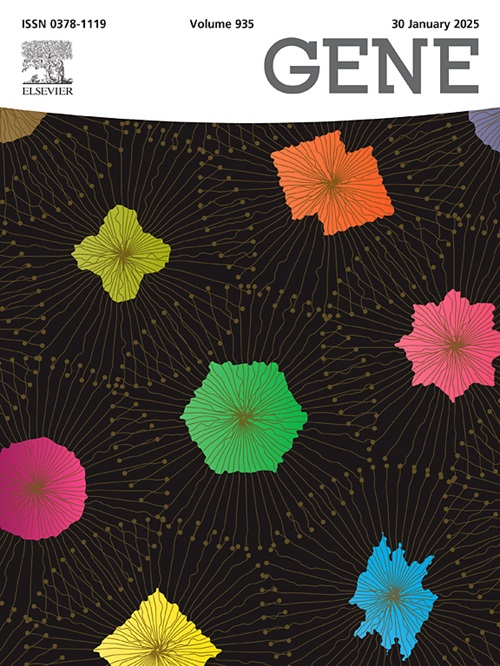LILRB4 in tumor-associated macrophage regulates macrophage polarization and glioblastoma progression via STAT3/IL10 axis
IF 2.4
3区 生物学
Q2 GENETICS & HEREDITY
引用次数: 0
Abstract
Background
Glioblastoma (GBM), the most aggressive primary brain tumor, exhibits a profoundly immunosuppressive tumor microenvironment (TME) dominated by M2-like tumor-associated macrophages (TAMs). The leukocyte immunoglobulin-like receptor B4 (LILRB4) has emerged as a critical immunoregulatory molecule implicated in cancer progression, yet its role in GBM remains poorly understood. This study investigated the expression, prognostic significance, and functional role of LILRB4 in TAM-mediated immunosuppression and GBM progression.
Methods
Expression patterns and prognostic significance of LILRB4 were analyzed using TCGA and validation datasets. Single-cell RNA sequencing (scRNA-seq), spatial transcriptomics (ST), and proteogenomics analyses identified cellular sources and spatial distribution of LILRB4. THP-1 cells were differentiated into TAM-like macrophages using PMA and tumor-conditioned medium (TCM) from GBM cells. LILRB4 was silenced using shRNA, and macrophage polarization markers were assessed by RT-qPCR, western blot, and ELISA.
Results
LILRB4 was identified as an independent prognostic factor in glioma, with high expression correlating with poor survival. Multiple bioinformatics approaches revealed strong LILRB4-M2 macrophage associations. ST revealed predominant LILRB4 expression in macrophage clusters with strongest tumor cell co-occurrence, identifying LAIR1 as a potential receptor. Proteogenomics analysis showed strong LILRB4 protein-mRNA correlations and associations with M2 markers. LILRB4 regulated macrophage polarization through the STAT3/IL10 axis. Knockdown reversed M2-like phenotype toward M1-like state, decreasing CD163, IL10, and TGFB1 while increasing IL1B and TNFA. TCM from LILRB4 knockdown macrophages significantly inhibited GBM cell proliferation.
Conclusion
LILRB4 might functions as a critical regulator of the immunosuppressive TME in GBM by promoting M2 macrophage polarization through the STAT3/IL10 axis. Targeting LILRB4 represents a promising approach for enhancing immunotherapeutic efficacy in GBM.
肿瘤相关巨噬细胞中的LILRB4通过STAT3/IL10轴调控巨噬细胞极化和胶质母细胞瘤进展。
背景:胶质母细胞瘤(GBM)是最具侵袭性的原发性脑肿瘤,具有由m2样肿瘤相关巨噬细胞(tam)主导的深度免疫抑制肿瘤微环境(TME)。白细胞免疫球蛋白样受体B4 (LILRB4)已成为参与癌症进展的关键免疫调节分子,但其在GBM中的作用仍知之甚少。本研究探讨了LILRB4在tam介导的免疫抑制和GBM进展中的表达、预后意义和功能作用。方法:采用TCGA和验证数据分析LILRB4的表达模式及预后意义。单细胞RNA测序(scRNA-seq)、空间转录组学(ST)和蛋白质基因组学分析确定了LILRB4的细胞来源和空间分布。用PMA和TCM将GBM细胞中的THP-1细胞分化为tam样巨噬细胞。采用shRNA沉默LILRB4,采用RT-qPCR、western blot和ELISA检测巨噬细胞极化标记物。结果:LILRB4在胶质瘤中是一个独立的预后因子,其高表达与生存差相关。多种生物信息学方法揭示了LILRB4-M2与巨噬细胞的强烈关联。ST显示,在与最强肿瘤细胞共存的巨噬细胞簇中,主要表达LILRB4,确定LAIR1是潜在的受体。蛋白质基因组学分析显示,LILRB4蛋白mrna与M2标记具有很强的相关性和相关性。LILRB4通过STAT3/IL10轴调控巨噬细胞极化。敲低将m2样表型逆转为m1样状态,降低CD163、IL10和TGFB1,同时增加IL1B和TNFA。中药敲除LILRB4可显著抑制巨噬细胞的增殖。结论:LILRB4可能通过STAT3/IL10轴促进M2巨噬细胞极化,从而在GBM中发挥免疫抑制TME的关键调节作用。靶向LILRB4是提高GBM免疫治疗效果的一种有希望的方法。
本文章由计算机程序翻译,如有差异,请以英文原文为准。
求助全文
约1分钟内获得全文
求助全文
来源期刊

Gene
生物-遗传学
CiteScore
6.10
自引率
2.90%
发文量
718
审稿时长
42 days
期刊介绍:
Gene publishes papers that focus on the regulation, expression, function and evolution of genes in all biological contexts, including all prokaryotic and eukaryotic organisms, as well as viruses.
 求助内容:
求助内容: 应助结果提醒方式:
应助结果提醒方式:


